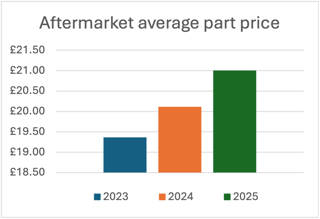The average distance that motorists drive between oil changes has fallen to 10,066 miles, representing a year-on-year fall of 5.5%, according to new data released by Castrol Professional.
This halts the prevailing seven-year trend that saw the number of miles travelled between oil changes rise steadily from 8,740 miles in 2003 to 10,657 in 2010, an increase of more than a fifth.
The data was based on responses from 3,051 private car owners and 1,240 company car buyers.
For cars in the 0-2 year car parc, the average mileage between oil changes is currently 10,993, dropping 7.2% to 10,202 among cars in the 3-4 year car parc.
This distance continues to decrease steadily throughout a car’s life – for cars in the 7-9 year bracket, the average mileage between lubricant services is 9,803, 10.8% lower than the newest cars on the road.
The research indicates that average mileages can vary dramatically according to fuel type.
Castrol Professional says that 0-2 year-old diesel cars currently travel, on average, more than 2,000 miles further between oil changes than petrol cars of a similar age.
Petrol vehicles in the 0-2 year car parc travel an average of 10,289 miles between oil changes, while diesel vehicles travel 12,455 miles – 21.1% further.
This gap shortens significantly in the 3-4 year car parc, with petrol cars travelling 10,085 miles compared to diesels’ 10,437 – only 3.5 per cent higher.
Castrol Professional notes that the fuel-specific gap in average mileage widens once more as cars get slightly older. In the 5-6 year bracket, diesel-powered cars travel an average 11,132 miles between two oil changes – 19.4% further than their petrol counterparts, travelling 9,322 miles. Among even older cars the gap reduces significantly.
Castrol believes that widening servicing and oil change intervals pose a challenge to aftersales departments – but also present a profit opportunity.
Jo Clayton, Castrol franchised workshop marketing manager – UK & Ireland, said: “Drivers travelling a greater distance between oil changes may visit the workshop less frequently, giving service advisors fewer opportunities to sell additional products and services.
“The proliferation of extended service intervals means many cars now require an oil top up between services, so service advisers should find it easier to explain the benefits of keeping a one-litre top up bottle in the car.
“It is a small preventative outlay now versus a potential engine rebuild later. Selling one-litre top up packs can also help a dealer fulfil their duty of care as it reassures the customer that they have the right oil for their car when they need it and that the dealer has their best interests at heart.”



















Ian Kendall - 27/06/2013 07:57
I would also argue that the mileage/age pattern is linked to newer cars being serviced on a mileage interval (commuters/fleet) while older vehicles would be serviced on time basis as 2nd/3rd owners would cover less miles between services.